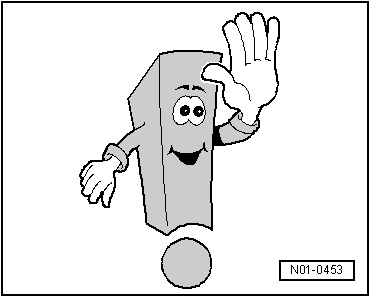Leon Mk1
|
Self-diagnosis function
Data bus
|
 |
|
|
Comprehensive information on the "data bus" is given in self study programme No. 186. Advantages:
The automatic gearbox control unit sends signals into the data bus and uses signals from it. It exchanges signals (information) with other control units. Examples of signals from data bus (sent by engine control unit)
Examples of signals into data bus (used by engine control unit)
Not only does the engine control unit exchange data with other control units, the other control units exchange data with each other via the data bus, as in this example. For example, the dash panel insert with diagnostic interface for data bus -J533- (or -J285-) receives the speed signal via the data bus from the automatic gearbox control unit. It is often the case that other systems can be coded. If they are incorrectly coded, faults often occur which do not have their origin in the automatic gearbox although a fault is stored in the fault memory of the automatic gearbox control unit. If the automatic gearbox control unit detects that signals are missing or faulty, the data bus itself, another system or a component of another system may be defective. Therefore, always perform self-diagnosis of affected control units. When using the current flow diagram to check the routing of wiring, please ensure that the data bus wiring is okay. Functions of gearbox control unit The automatic control unit -J217- receives information from components that effect selection of gears and passes the information on to solenoid valves that control the valves in the valve body. Control unit -J217- with driving situation gear changes (fuzzy logic) Determining the driving situation and driving resistance dependent gear change point happens automatically. Advantages:
Hill program - gear change point variations for gradients An additional gear change map automatically selects gear changes for gradients dependent upon accelerator pedal position and driving speed.
Vehicles with diesel engine (stationary de-coupling) To increase comfort in these vehicles, the control unit selects neutral when driving range "D" or "R" is selected if the vehicle is stationary, the engine is idling and the brake pedal is depressed. Gearbox control unit fault recognition The control unit is equipped with a fault memory so that in the event of an electronic/electrical component failure or an open circuit the fault can be determined quickly. Fault are recognized by electrical signals and stored in the fault memory. The control unit recognizes faults during vehicle operation and stores them in a fault memory => Fault tables, from page 01-17 After analysing the information the control unit distinguishes between sporadic faults and faults present at this moment (static) and stores these. If the fault is not present for a predetermined time or when driving over a longer distance, it is no longer recognized and becomes a sporadic fault. A fault is also changed to a sporadic fault when the fault memory is not erased after repairs. Faults which are stored in the memory as sporadically occurring faults, will be displayed as "sporadic faults" when retrieved by fault reader V.A.G 1551. "SP" appears on the right of the display in such cases. If the printer is switched on, "sporadic faults" are printed out after the fault is addressed. If the sporadic fault is not present for a predetermined time or when driving over a longer distance, the fault is erased in the fault memory. Safety functions of gearbox control unit If faults occur whilst driving, the control unit can activate supplementary functions or an emergency running programme. They can affect the quality and function of the gear changes. Depending on the seriousness of the fault, the engine control unit can react by:
The gearbox will remain in emergency running mode; until the fault is no longer recognized by the control unit over a predetermined period. Faults which may lead to emergency running: Open circuit in wiring, short-circuit, electrical or hydraulic components defective. Wiring open circuit and/or data bus wiring short circuit. Renewing control units If the engine and gearbox control units are renewed, the system must be put into the basic setting , Initiating basic setting. Fault reader V.A.G 1551 and tester VAS 5051 Electrical faults that affect vehicle performance can be determined with these devices. Fault reader V.A.G 1551
|
